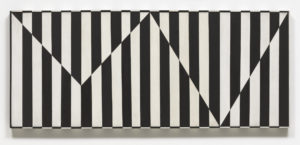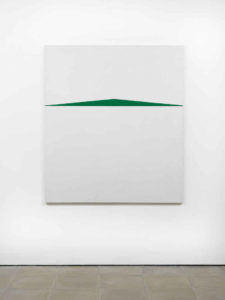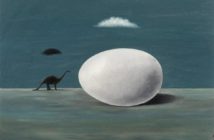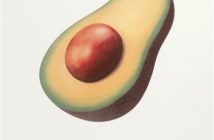Dear Artist,
In 2004, Carmen Herrera was a painter living in obscurity on East 19th Street, near Union Square in New York City. Widowed four years earlier by her schoolteacher husband of 61 years, she was now on her own in their loft apartment but looked-in on by her friend and neighbour, Tony Bechara. Tony was also a painter. After a dealer of Latin American Art mentioned that one of his artists had dropped out of an upcoming show, Tony recommended Carmen. When the paintings arrived at the Tribeca gallery, the dealer, Frederico Sève said, “There’s something here.”
A short review appeared. “This crisp handsome show picks up a thread of geometric abstraction in 20th-century Latin American art, and follows it in the work of three women who have made significant contributions to the history of that art,” wrote Holland Cotter for the New York Times. “The senior artist, who is also the least well known, is Carmen Herrera, who was born in Cuba in 1915 and has lived in New York City since 1954. Her declarative, witty, hard-edge style has points of contact with Mondrian, Ellsworth Kelly and Op Art, but is most immediately connected to the vanguard Neo-concrete work of artists like Lygia Clark and Hélio Oiticica who flourished in Brazil after World War II.” Quickly, a trio of prominent collectors gobbled up the show. At 89, Carmen had finally sold her first painting, and then some.
Soon, Carmen’s work was travelling across Europe in solo exhibitions, then a retrospective. She found herself in the great museums, now nestled between her long-famous contemporaries; Stella, Kelly, Martin, Johns. A critic for the Observer of London asked, “How can we have missed these brilliant compositions?”, calling her “the discovery of the decade.”
Sincerely,
Sara
PS: “I do it because I have to do it; it’s a compulsion that also gives me pleasure. I never in my life had any idea of money, and I thought fame was a very vulgar thing. So I just worked and waited. And at the end of my life, I’m getting a lot of recognition, to my amazement and my pleasure, actually.” (Carmen Herrera)
“Ms. Herrera is an example of an artist persisting in her work, unaffected by lack of recognition, a lack of sales, pursuing her vision with great rigor and self-confidence and happily receiving recognition late in life.” (Jamer Meyer, curator of modern art at the National Gallery of Art in Washington)
Esoterica: By 94, Carmen was arthritic and wheelchair bound, but still making art with the help of an assistant, who made trips to the paint store and followed her drawings and instructions. Her lifetime of paintings, once piled and leaning around the loft – some on the radiator – were now archived off-site in a climate-controlled art storage facility. Carmen was also now able to afford the full-time help required to safely remain at home. By her 100th birthday, Carmen was the subject of a documentary in preparation for her retrospective at the Whitney, which opened in 2016.
In the 1960s, after studying at the Art Students League, then relocating to Paris, then returning to New York, Carmen showed with her contemporaries, but her work didn’t sell. Nonetheless, some critics took notice. “Within the limits of the geometrical and hard-edge modes, a painter’s success often depends on a correct gauging of what personal innovations are possible within the impersonal conventions of these styles,” wrote Hilton Kramer for the New York Times. “Miss Herrera shows a canny understanding of this problem and is thus able to confer something distinctly her own.” Carmen Herrera passed away at home on East 19th Street on February 12, 2022, just shy of her 107th birthday, which is on May 30.
“There’s a saying that you wait for the bus and it will come. I waited almost a hundred years.” (Carmen Herrera)
You can rent Alison Klayman’s 2016 documentary The 100 Years Show, here.
“You cannot talk about art. You have to art about art. Then you know something.” (Carmen Herrera)
Have you considered a Premium Artist Listing? With each letter, an artist is featured at the bottom of this page. The Premium Artist Listings are a means of connecting artist subscribers through their work. Proceeds from each listing contribute to the production of The Painter’s Keys.
Featured Artist
My art represents an artistic journey that has been on-going for more than thirty-five years with help and guidance from many wonderful artists. Now, with years of plein-air painting experience, study and solo exhibitions, I believe that my current work has reached its highest level, reflecting the depth of my absorption in the wonder and beauty of the world around me. I have learned that, as an artist, I will never stop looking for better ways to express my feelings in art and that struggling to more fully understand myself is integral to my painting; a philosophy that was part of every workshop I taught. Still is.









12 Comments
Positively inspiring!! What a wonderful woman.
Definitely a lesson for artists in focusing on creating our best work and patience but what does this story say about the art world in that it was so incredibly slow to notice and celebrate her work? We missed out on all those years of enjoyment and discovery and conversation with this amazing artist! What were we thinking? It isn’t as if she was completely unknown and outside of the New York art scene. There is something worth examining here as art galleries and art collectors and art lovers of all sorts. I suspicious that Carmen Herrera’s bus took way longer than it should have to come in.
Tony Bechara is the only reason she was rediscovered. When her early work , excellent as it was, didn’t sell, SHE had been discarded by the art system. But as a neighbor and long time friend, why hadn’t he promoted her work long before that vacancy happily appeared? He’s very well known and connected. Perhaps she held him off because of her acute assessment that fame and sales are vulgar? Whatever the reason for his and the art system’s lack of verve (balls) earlier on, thank goodness she was found.
Wonderful to hear of her innovative artwork and life. Thank you, Sara
Where do you find these inspiring stories Sara? Thank you so much…. I’ll just keep painting.
And I bet you any money she was an HSP. Wow, what a story, thank you, Sara!!
Some of us who are only 88 can be inspired by her story, and just keep on painting!
This story kind of reminds me of Marty McFly shredding on his ES-345 to Johnny B. Goode – the world just wasn’t ready for Herrera until it was ready. At least it happened in her lifetime with the right champion of her work at the right time. I am happy she was able to see people noticing what she already knew. Could have been worse – look at Van Gogh – if not for his sister-in-law, his work would have been lost in obscurity to history – both Vincent and Theo died never knowing how widely cherished his work was and now is. In some ways she was lucky.
The “compulsion that also gave her pleasure” never seemed to leave her and to me remains in her bold and amazing artwork. Thank you for this story, Sara – so inspiring!
This was just what I needed. To see someone alert and talking and woking at over age 100 is inspirational. I sometimes think there isn’t much time left, but I think I should let that thought go. Thank you!
I guess there is yet hope for me. I’m 93, still painting in oils. I’ve written and published six books since 2000. I also play the piano. I’m convinced my creativity is what keeps me going. I’m enthusiastic and happy due to art. I’m now working (100+ pages ) on a sequel to one of my books. Artists – don’t ever stop doing what makes you happy.
I am so glad that Carmen began to experience her fame before she passed away. So many don’t.